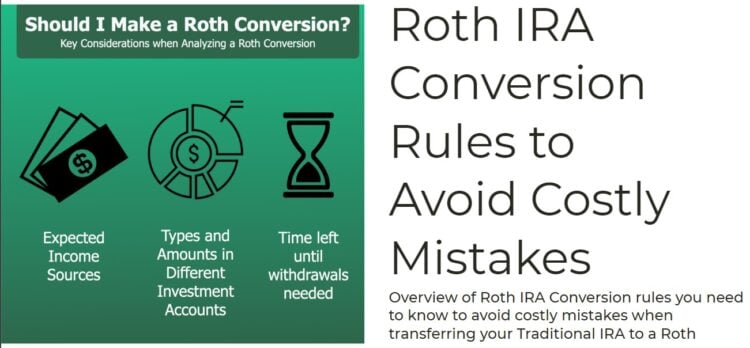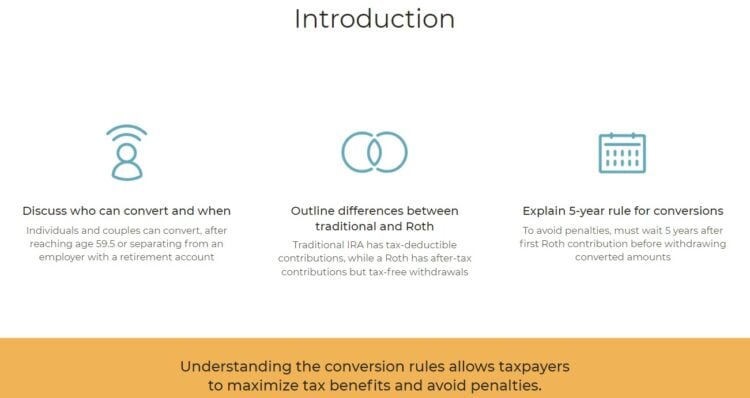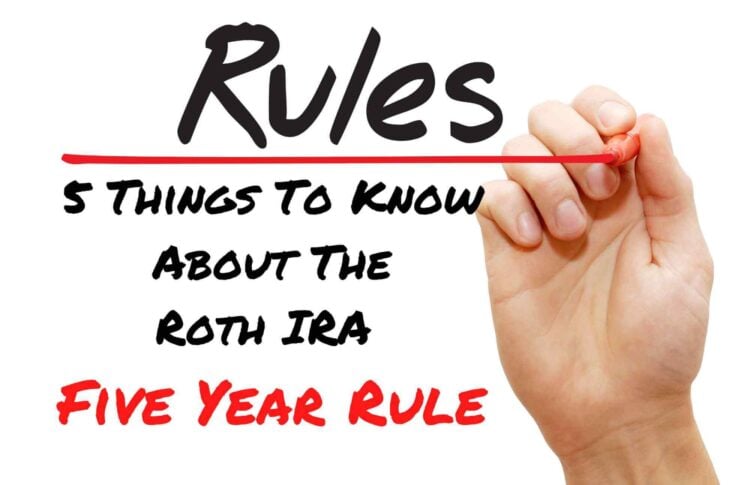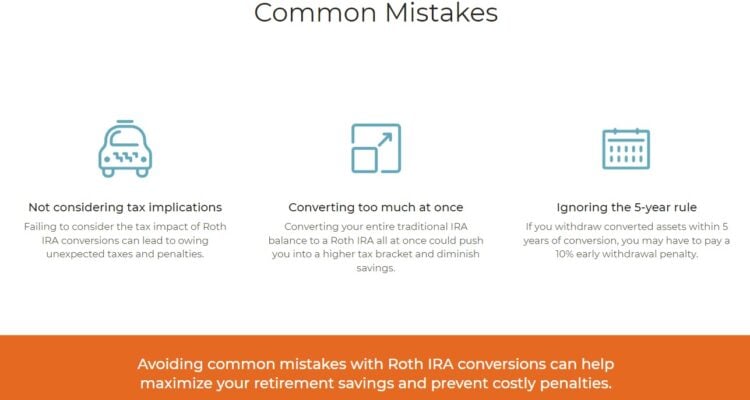
After nearly 30 years of helping clients navigate retirement, I’ve seen Roth IRA conversions create tremendous tax-free wealth. But even if you don’t convert, you can learn about ways to max out your Roth IRA contributions here.
I’ve also seen simple mistakes cost families thousands in unexpected taxes. The difference is knowing the Roth Conversion rules.
A client, we’ll call him “Strategic Steve”, came to me with a large Traditional IRA. He was worried about a huge tax bill in retirement. We built a multi-year Roth conversion plan that saved his heirs an estimated six figures in taxes.
On the other hand, I’ve seen people get blindsided by the “pro-rata rule” and pay taxes they never expected.
This guide is my 25+ year playbook, distilled into a clear, actionable plan. We’ll break down the essential rules, from the dreaded Pro-Rata Rule to the 5-Year Clock, helping you decide if a conversion is right for you and how to do it without IRS headaches.
Key Takeaways of Roth Conversions
Conversions are Taxable: Converting pre-tax funds from a Traditional IRA/401(k) to a Roth IRA is a taxable event. The amount you convert is added to your income for the year.
- There are NO Income Limits: Anyone can convert to a Roth IRA, regardless of how high their income is.
- The Pro-Rata Rule is a Major Trap: If you have any other pre-tax IRA assets (like a Rollover or SEP-IRA), your conversion may be partially taxable, even if you use non-deductible funds.
- The 5-Year Rule is Crucial: Each conversion has its own 5-year waiting period before you can withdraw the converted principal penalty-free before age 59 ½.
- Mistake Buster: A Roth Conversion is IRREVERSIBLE. The ability to “undo” a conversion (recharacterize) was eliminated by the Tax Cuts and Jobs Act of 2017.
Quick Answers About Roth IRA Conversions
What Is a Roth IRA Conversion (And Why Is It a Powerful Tool)?

A Roth IRA conversion is the process of moving money from a pre-tax retirement account, like a Traditional IRA, SEP-IRA, or old 401(k), into a post-tax Roth IRA.
The core trade-off is simple: you choose to pay income taxes on the converted amount today in exchange for the promise of completely tax-free growth and tax-free withdrawals in retirement.
For many, this is a brilliant long-term strategy to protect against the risk of higher taxes in the future.
The 5 Core Conversion Rules You Must Know in 2025
Navigating a conversion successfully means understanding five key rules. Getting these wrong can lead to unnecessary taxes and penalties.

Rule #1: There Are No Income or Conversion Limits
Unlike regular Roth IRA contributions, which have strict income limits, there are no income restrictions on performing a Roth conversion. There is also no limit to the amount you can convert in a single year. However, converting too much at once can be a costly mistake, as we’ll see.
Rule #2: The Infamous “5-Year Rule” (There are Two of Them!)
This is one of the most misunderstood concepts in retirement planning. There isn’t just one 5-year rule; there are two, and they work differently.
💡 Michael Ryan Money Tip: The Two Clocks
Think of it like having two different clocks running. The first clock starts with your very first contribution to any Roth IRA. Once that clock has run for five years, all your earnings can be withdrawn tax-free (after age 59 ½). The second clock starts on January 1st of the year you make a conversion. Each new conversion has its own separate 5-year clock for withdrawing the *principal* penalty-free before 59 ½.

For a complete breakdown, see my detailed guide on the Roth IRA Five Year Rule.
Rule #3: The Pro-Rata Rule (The Backdoor Roth User’s Biggest Trap)
This is, without a doubt, the #1 trap for DIY investors. The pro-rata rule states that if you have any pre-tax funds in any Traditional, SEP, or SIMPLE IRAs, you cannot simply convert only your after-tax contributions tax-free.
The IRS treats all of your IRAs as one giant account for tax purposes. Your conversion is considered a proportional mix of pre-tax and after-tax dollars.
🔍 Pro-Rata Rule Explained with Numbers
Let’s say you have a $90,000 Rollover IRA (all pre-tax money). For a Backdoor Roth, you contribute $10,000 in after-tax money to a new Traditional IRA. Your total IRA balance is now $100,000, of which only 10% is after-tax. If you try to convert that $10,000, the IRS says only 10% ($1,000) is tax-free. You just got a surprise tax bill on the other $9,000.
Rule #4: You Must Take Your RMD First
If you are age 73 or older and subject to Required Minimum Distributions (RMDs), you must take your RMD for the year before you can convert any funds from that IRA.
An RMD amount is not eligible for conversion.
Rule #5: Conversions are PERMANENT
This is a critical update that many online articles get wrong.
⚠️ Myth Busted: You Can “Undo” a Roth Conversion
The Truth: Prior to 2018, you could reverse or “recharacterize” a Roth conversion. This was eliminated by the Tax Cuts and Jobs Act of 2017. Today, once you convert funds to a Roth IRA, the decision is permanent and irreversible. There are no do-overs.
The Planner’s Playbook: How to Do a Roth Conversion Step-by-Step
- Open a Roth IRA Account: If you don’t already have one, open a Roth IRA at a reputable brokerage. Starting an account is the first step to start a Roth IRA.
- Contact Your Custodian: Call the institution holding your Traditional IRA/401(k) and tell them you want to initiate a Roth conversion. The easiest way is a direct trustee-to-trustee transfer.
- Prepare to Pay the Taxes: This is crucial. To get the full benefit, you should pay the income tax on the conversion with money from a non-retirement account (like a checking or savings account).
- File IRS Form 8606 with Your Tax Return: You must report the conversion to the IRS using Form 8606. This form is used to report non-deductible contributions and conversions.
Common Roth Conversion Mistakes I’ve Seen in 25 Years

📘 A Planner’s War Story: The RMD Mistake
I once had a new client who converted $50,000 from his IRA to a Roth in January. He was 75 and thought he was being proactive. The problem? He hadn’t taken his $20,000 RMD for the year yet. The IRS treated the first $20,000 of his conversion as a failed RMD, hitting him with a penalty, and then taxed him on the $50,000 conversion. It was a costly and completely avoidable mess.
- Mistake #1: Paying the Taxes From the IRA Itself.
This reduces the amount of money that goes into your Roth to grow tax-free and can trigger an early withdrawal penalty if you’re under 59 ½. - Mistake #2: Ignoring the Pro-Rata Rule.
This is the most common and costly error for people attempting a Backdoor Roth IRA. - Mistake #3: Converting Too Much at Once.
A large conversion can easily push you into a higher tax bracket, increasing the cost of the conversion and potentially impacting Medicare premiums.
Frequently Asked Questions about Roth Conversions
What is the downside of a Roth conversion?
The main downside is the immediate and often large tax bill. The entire pre-tax amount you convert is added to your taxable income for that year, which can be a significant financial hit.
How can I avoid paying taxes on a Roth conversion?
You can’t avoid taxes on pre-tax money. The only way to have a tax-free conversion is by converting after-tax (non-deductible) contributions from a Traditional IRA, and only if you have no other pre-tax funds in any of your other IRAs.
What is the deadline for a Roth conversion?
A Roth conversion must be completed by December 31st to be included in that year’s taxable income. There is no extension for conversions like there is for contributions.
Your Next Move: Is a Roth Conversion Right for You?
A Roth IRA conversion is one of the most powerful tax-planning tools for retirement, but it’s not the right move for everyone. The decision depends entirely on your current and expected future financial situation.
💡 Key Insight: Understanding the Pro‑Rata Rule
The IRS treats all your traditional, SEP, and SIMPLE IRA balances as one when applying the pro‑rata rule—meaning you can’t convert just your after‑tax funds. If only 6% of your IRA contributes after-tax, only 6% of your conversion is tax-free, and the rest is taxable income.
- Sharing the article with your friends on social media – and like and follow us there as well.
- Sign up for the FREE personal finance newsletter, and never miss anything again.
- Take a look around the site for other articles that you may enjoy.
Note: The content provided in this article is for informational purposes only and should not be considered as financial or legal advice. Consult with a professional advisor or accountant for personalized guidance.
